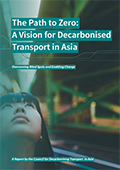The main objective of the Council for Decarbonising Transport in Asia’s Flagship Report is to spotlight both the opportunities and challenges associated with achieving zero emissions in transport by 2050 in Asia.
Addressing “blind spots,” or areas that the Council believes do not receive adequate attention in relation to their potential contribution to decarbonisation, is key to delivering this sustainable mobility.

Addressing the threat of climate change
The data speaks for itself, and its words are not so rosy.
Global average temperature has already increased by around 1 degree Celsius above pre-industrial levels, which has led to severe impacts.
Without decisive action, impacts will get worse, as the world is heading toward an average increase of around 2.7 degrees Celsius by the end of the century even if all current commitments made by countries under the Paris Agreement are met.
Acting on climate change is not a luxury – it is imperative for future economic and social stability.
We are already facing stark consequences of climate change today.
Relative to average of 1971-2000 [°C]
Addressing the threat of climate change
The data speaks for itself, and its words are not so rosy.
Acting on climate change is not a luxury – it is imperative for future economic and social stability.
We are already facing stark consequences of climate change today.
The last 20 years included 18 of the warmest years on record and saw an increase in frequency and severity of hazards such as wildfires.
Disasters in 2017 triggered by weather and climate-related hazards led to a $320 billion loss globally, with devastating floods in South Asia taking over 1,200 lives in the same year.
Infrastructure disruptions cost the private sector around $300 billion each year, a third of which is in the transport sector, according to the World Bank.
Increasing floods, crop yield decline, water shortages in arid areas, and increased mortality from heat have also been observed in different parts of Asia.


Read the Council's report
Download the report
The transition to a strong, sustainable, balanced, and inclusive growth can address climate change and deliver vast economic and social benefits, but the window of opportunity is closing.
This is where transport, which was responsible for 25% of direct CO₂ emissions from fuel combustion in 2018, plays a key role.
Achieving the Paris Agreement goals is out of reach without a transformation of the transport sector to zero-carbon mobility.
- The CO₂ emissions from the transport sector in Asia increased by 243% between 1990 and 2018, with the region now responsible for 27% of global sector emissions – up from 14% in 1990.
- Emissions in Asia are expected to increase another 48% between 2015 and 2050.
- Asia represented 39% of global freight activity in 2015, but the number is estimated to jump to 46% by 2050.
Transport must contribute to the reduction in order to reduce global emissions to net-zero.

Decisions now will impact the future competitiveness of countries and industries, and provide a unique opportunity.
Rather than just spending more, the focus is on spending better. By Hallegatte, et al.

Statements of broad intent and incremental steps are not enough, we need bold action with clear policy signals to reduce market uncertainty and step up private investment to capture these benefits.
The Global Commission on the Economy and Climate concluded that bold action could yield a direct economic benefit of $26 trillion through 2030 compared with maintaining the current state of things, which, in turn, can result in more than 65 million additional low-carbons jobs, increased female employment and labor participation as well saving 700,000 people from premature deaths caused by air pollution.
Additionally, the more we mitigate, the less we will have to adapt to climate change-induced disruptions.
Developments in transport have been made as societies change, but there is still much to do.
Developments in transport have been made as societies change, but there is still much to do.

Developments in transport have been made as societies change, but there is still much to do.
- More and more companies are setting science-based targets or net- zero targets.
- Internal combustion engine (ICE) phase-out is on the rise globally – but not yet common in Asia.
- Growing awareness of climate change risks is changing public perception.
- Financial systems are increasingly pulling out of polluting activities.
- Capital markets are increasingly taking climate change risk into consideration.
More and more companies are setting science-based targets or net- zero targets.
Internal combustion engine (ICE) phase-out is on the rise globally – but not yet common in Asia.
Growing awareness of climate change risks is changing public perception.
Financial systems are increasingly pulling out of polluting activities.
Capital markets are increasingly taking climate change risk into consideration.